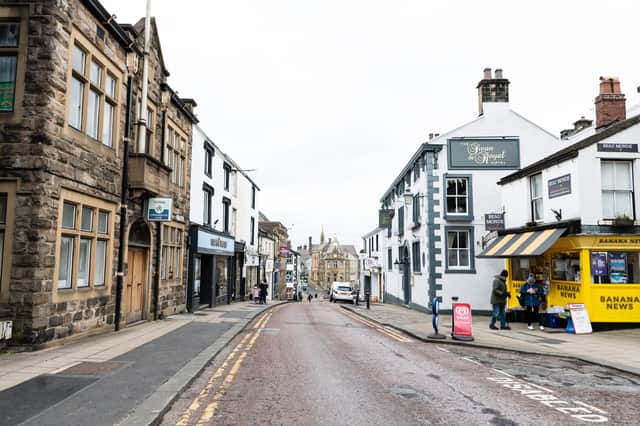Clitheroe Civic Society talk on historic buildings courtesy of Ormskirk and District Family History Society member


Kate, an active member of the Ormskirk and District Family History Society, is currently looking at the 1826 weavers’ uprising.
She made a difficult choice from the 116 listed buildings in Clitheroe and took members on a walk through Castle Street and Church Street, pausing first at the Swan and Royal Hotel.
Advertisement
Hide AdAdvertisement
Hide AdAn article in Manchester Mercury of March 1754 described it as “the house of William Hayes, known by the sight of the swan”.
William Hayes died in 1769, and later occupants were discovered to be Robert and Seth Wood, brothers from Billington.
Rogerson’s Directory of 1818 confirms The Swan as a coaching inn, listing a five hour coach journey to Manchester on Tuesdays and Saturdays. Coincidently, the journey ended in Manchester at an inn in Market Street, also called The Swan.
Thomas Silverwood was the landlord for around seven years until his death in 1822. An 1822 survey showed that in addition to the the inn with its yard, garden and stables, his widow Jane also rented over eight acres of land.
Advertisement
Hide AdAdvertisement
Hide AdIn 1832, Jane Silverwood , then in her late 60’s, is noted in a sales advert for ‘coach houses, pastures and stables’. By this time the Swan was well established as a popular destination for travellers.
Next door to the Swan is a retail shop, now known as Banana News. It’s listing by Historic England suggests it has 1770 origins.
The tithe map of 1842 shows the building and passageway to the Swan Courtyard. In 1851 house numbers were introduced and Banana News was allocated number 26, occupied at that time by John and Susannah Dawson, grocers and fruiterers.
Their daughter became a teacher at the early St Michael and St John’s school. Their son, Walter, took over the shop as a fish, game and poultry purveyor and was still there in 1908.
Advertisement
Hide AdAdvertisement
Hide AdA Christmas advertisement that year has Frederick and Walter Dawson promoting their goods – turkeys, geese, ducks, pheasants and the like.
Moving onward to Church Street, which has fourteen listed buildings on its length, the society heard about some of the traders, their work and their home addresses, recorded in the 1818 Rogerson’s directory.
A labourer, James Townsend, is noted, but most of those recorded were offering luxury goods – confectionery, watches and alcohol. A calico manufacturer and printer was evidence of the thriving textile industry of the time.
The Watson family resided on Church Street for around 35 years. Henry and Margaret Watson had nine children, all baptised at St Mary’s Church. The family business of ‘Curriers and leather sellers’ was conducted from the double fronted shop premises, opposite ‘Almonds’.
Advertisement
Hide AdAdvertisement
Hide AdAlmonds,19 Church Street, is dated by its Historic England listing as the late 1700’s.
In 1782 it was owned by Lord Galway who rented it to Clement Proctor, a nail-maker.
Clement Proctor was a Quaker who died in 1791 and was interred at the Quaker burial ground at Sawley.
The Society’s next presentation, “An Unexpected Inheritance” by Robert Parker DL, of Browsholme Hall, will be on November 6th at St Michael and St John’s Hall at 7-30pm. Members and students free, visitors £3.